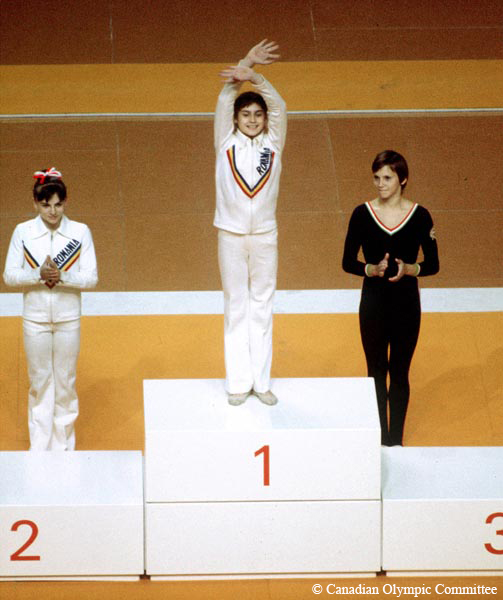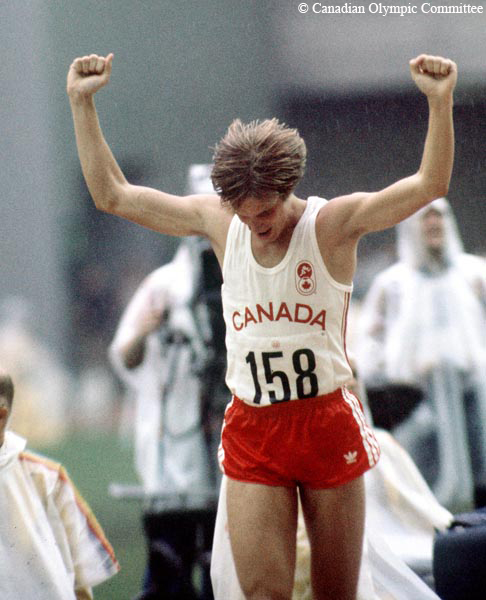By Dalton Campbell

The Olympic cauldron is lit during the opening ceremonies of the XXI Summer Olympic Games, Montréal, July 17, 1976. ©Canadian Olympic Committee
Montréal, Quebec was awarded the games in the second round of voting by Olympic delegates in 1970. After the first ballot, Moscow was leading Montréal 28 votes to 25, resulting in third-place Los Angeles being automatically eliminated. The Montréal bid received most of the Los Angeles support and was selected as host city.

The delegations of participating countries gather during the opening ceremonies for the XXI Summer Olympic Games, Montréal, July 17, 1976. ©Canadian Olympic Committee
Construction of the Olympic facilities was slow due to complicated architectural designs, the rapid inflation rate and governments reluctant to commit to funding. Exceptionally cold weather halted construction in January 1976. When the games started, 19 of the 21 facilities were finished; however the Olympic Stadium, the centrepiece, was not completed when the games began.
Nadia Comaneci, a 14-year-old gymnast from Romania, was perhaps the biggest star of the Montréal games. In the opening days of the Olympics, she earned an unprecedented perfect 10.00 for her routine on the uneven bars. However, as the score board was equipped with only three digits, the judges—in uncharted territory—displayed scores of “1.00.”

Romania’s Nadia Comaneci (centre) waves to the crowd after her gold medal win in the uneven bars during the gymnastics competition at the XXI Summer Olympic Games. She went on to earn five medals, including three gold. The silver medal is awarded to Teodora Ungureanu of Romania (left) and the bronze to Márta Egervári of Hungary (right). Montréal, July 1976. ©Canadian Olympic Committee
Apparently at a meeting before the 1976 Olympics, there had been a discussion to use score clocks with four digits. The decision was to use three-digit clocks because a perfect ten was impossible.
Michel Vaillancourt, riding his horse Branch County, was the first Canadian to earn an individual equestrian medal at the Olympics. Born northeast of Montréal, he was performing in front of his hometown crowd when he won a silver medal in individual show jumping.

Canada’s Michel Vaillancourt rides Branch County in an equestrian event at the XXI Summer Olympic Games, Montréal, July 1976. ©Canadian Olympic Committee
On the last day of the games, the high jump competition was held in the rain. The world record holder, Dwight Stones of the United States, had been favoured to win. After an interview in which he appeared to criticize the facilities and the hosts, he was booed by the crowd. Stones, who disliked jumping in wet conditions, struck the bar and was eliminated. The next athlete, Canada’s Greg Joy, cleared the bar, bringing the crowd of almost 70,000 to their feet in a standing ovation. Joy would finish with the silver medal, ceding the gold to Jacek Wszola of Poland.

Canada’s Greg Joy competes in the high jump event at the XXI Summer Olympic Games, Montréal, July 1976. ©Canadian Olympic Committee
Although no Canadian earned a gold medal at the 1976 games, Greg Joy was cheered and honoured as if he had. He was named flag bearer for the closing ceremonies. Later that year he received the Lionel Conacher Award as Canada’s male athlete of the year, beating out jockey Sandy Hawley and hockey superstar Guy Lafleur. For many years afterwards, his jump and celebration were replayed nightly across the county; it was the second-last clip in the O Canada video shown on CBC television immediately before the network signed off for the night.

Greg Joy after winning the high jump event at the XXI Summer Olympic Games, Montréal, July 1976. ©Canadian Olympic Committee
The closing ceremonies were held on August 1, 1976. Canada finished the games with five silver and six bronze medals—more than double the number of medals won by Canada in 1968 or 1972.
Additional Resources
- Canadian Olympians database (archived)
- Canadian Olympic Association fonds
- Roger Rousseau fonds
- Glynn A. Leyshon collection
- Jean-Claude Pilon collection
- The Montreal Star fonds
Dalton Campbell is an archivist in the Science, Environment and Economy Section of the Private Archives Division.
